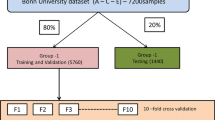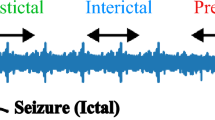Abstract
Epilepsy seizure classification has been an ongoing research from decades. Auto seizure detection methods are developed by many researchers. Year by year new methods and new approaches are introduced by researchers to improve the performance of these automatic detection methods. Electroencephalogram (EEG) is the most widely used tool for detecting seizure as it has high resolution which makes it more feasible for analysis. In this paper we are introducing an approach based on stacked bidirectional long short term memory with global average pooling (LSTM_GAP) neural network for detecting epileptic seizure events. We use open access EEG dataset available in Bonn University Germany for the experiment. The model is evaluated based on three performance metrics, specificity, sensitivity and accuracy. It resulted with outstanding performance with 100% accuracy, sensitivity and specificity in detecting epileptic seizure events which is the highest accuracy among all the techniques available in state-of-the art literature. Another advantage of LSTM_GAP model lies in its robustness in noise. In real, the EEG recorded in hospital laboratories consists of artefacts generated from eye blink and muscle activities of the patients. When our model will be put to practical use by the neurologists, the EEG recordings consisting of artefacts will be given as input to the model for detecting seizure events. Hence we need to develop a model which is robust against noise and which can provide good results even when the EEG data consisting artefacts is given as input. Hence we extended our experiment to check the performance of the LSTM_GAP model by adding eye blink artefacts and muscle artefacts to the input EEG data. The model was able to give superior results even after adding artefacts. We were able to achieve 97.67% sensitivity, 98.83% specificity and 97.65% accuracy. Thus LSTM_GAP model gives superior results for the EEG with and without noise compared to other methods in the literature.












Similar content being viewed by others
References
Tandle A, Jog N (2015) Classification of artefacts in EEG signal recordings and overview of removing techniques. Int J Comput Appl 975:8887
Väisänen O, Malmivuo J (2009) Improving the SNR of EEG generated by deep sources with weighted multielectrode leads. J Physiol Paris 103:306–314
Lin M, Chen Q, Yan S (2014) Network In Network, arXiv:1312.4400v3 4 Mar 2014.
Pereira LAM, Papa JP, Coelho ALV, Lima CAM, Pereira DR, de Albuquerque VHC (2019) Automatic identification of epileptic EEG signals through binary magnetic optimization algorithms. Neural Comput Appl 31:1317–1329. https://doi.org/10.1007/s00521-017-3124-3
Murali Krishna N, Sekaran K, Vamsi AVN, Pradeep Ghantasala GS, Chandana P, Kadry S, Blazauskas T, Damasevicius R (2019) An efficient mixture model approach in brain-machine interface systems for extracting the psychological status of mentally impaired persons using EEG signals. IEEE Access 7:77905–77914. https://doi.org/10.1109/ACCESS.2019.2922047
Munoz R, Olivares R, Taramasco C, Villarroel R, Soto R, Alonso-Sánchez MF, de Albuquerque VHC (2018) A new EEG software that supports emotion recognition by using an autonomous approach. Neural Comput Appl. https://doi.org/10.1007/s00521-018-3925-z
Butkeviciute E, Bikulciene L, Sidekerskiene T, Blazauskas T, Maskeliunas R, Damasevicius R, Wei W (2019) Removal of movement artefact for mobile EEG analysis in sports exercises. IEEE Access 7:7206–7217. https://doi.org/10.1109/ACCESS.2018.2890335
Raghavendra U, Rajendra Acharya U, Adeli H (2019) Artificial intelligence techniques for automated diagnosis of neurological disorders. Eur Neurol 82:41–64
Shamim Hossain M, Amin SU, Alsulaiman M, Muhammad G (2019) applying deep learning for epilepsy seizure detection and brain mapping visualization. ACM Trans. Multimedia Comput. Commun. Appl., Vol. 15, No. 1s, Article 10. Publication date: February 2019
Hussain L (2018) Detecting epileptic seizure with different feature extracting strategies using robust machine learning classification techniques by applying advance parameter optimization approach. Cogn Neurodyn. 12:271–294
Eberlein M, Hildebrand R, Tetzlaff R, Hoffmann N, Kuhlmann L, Brinkmann B, Müller J (2018) Convolutional Neural Networks for Epileptic Seizure Prediction, arXiv:1811.00915v2 5 Nov 2018.
Acharya UR, Oh SL, Hagiwara Y, Tan JH, Adeli H, “Deep convolutional neural network for the automated detection and diagnosis of seizure using EEG signals”, Epub 2017 Sep 27
O'Shea A, Lightbody G, Boylan G, Temko A (2020) Neonatal seizure detection from raw multi-channel EEG using a fully convolutional architecture. Neural Netw 123:12–25. https://doi.org/10.1016/j.neunet.2019.11.023
Virgilio G CD, Sossa A JH, Antelis JM, Falcón LE (2020) Spiking neural networks applied to the classification of motor tasks in EEG signals. Neural Netw 122:130–143. https://doi.org/10.1016/j.neunet.2019.09.037
Wei C, Chen L, Song Z, Lou X, Li D (2020) EEG-based emotion recognition using simple recurrent units network and ensemble learning. Biomed Signal Process Control. https://doi.org/10.1016/j.bspc.2019.101756
Zhang J, Yao R, Ge W, Gao J (2020) Orthogonal convolutional neural networks for automatic sleep stage classification based on single-channel EEG. Comput Methods Programs Biomed. https://doi.org/10.1016/j.cmpb.2019.105089
Abdelhameed AM, Daoud HG, Ayoumi M (2018) Deep Convolutional Bidirectional LSTM Recurrent Neural Network For Epileptic seizure detection. In: 16th IEEE International New Circuits and Systems Conference (NEWCAS)
Usman SM, Usman M, Fong S (2017) Epileptic seizures prediction using machine learning methods. Hindawi Comput Math Methods Med 2017:10 Article ID 9074759
Jaafar ST, Mohammadi M (2019) Epileptic Seizure Detection using Deep Learning Approach. UHD J Sci Technol 3(2):41–50
Boonyakitanont P, Lek-uthai A, Chomtho K, Songsiri J (2019) A Comparison of Deep Neural Networks for Seizure Detection in EEG Signals, bioRxiv preprint first posted online Jul. 15
Arunkumar N, Ramkumar K, Venkatraman V, Abdulhay E, Fernandes SL, Kadry S, Segal S (2017) Classification of focal and non-focal EEG using entropies. Pattern Recogn Lett 94:112–117
Fernandes SL, Josemin Bala G (2017) A novel decision support for composite sketch matching using fusion of probabilistic neural network and dictionary matching. Curr Med Imaging Rev 13(2):176–184
Raza M, Sharif M, Yasmin M, Khan MA, Saba T, Fernandes SL (2018) Appearance based pedestrians’ gender recognition by employing stacked auto encoders in deep learning. Future Gener Comput Syst 88:28–39
Amin J, Sharif M, Yasmin M, Fernandes SL (2018) Big data analysis for brain tumor detection: Deep convolutional neural networks. Future Gener Comput Syst 87:290–297
Ansari GJ, Shah JH, Yasmin M, Sharif M, Fernandes SL (2018) A novel machine learning approach for scene text extraction. Future Gener Comput Syst 87:328–340
Rajinikanth V, Raja NSM, Satapathy SC, Fernandes SL (2017) Otsu's multi-thresholding and active contour snake model to segment dermoscopy images. J Med Imaging Health Inform 7(8):1837–1840 (Impact Factor: 0.549)
Raja NSM, Rajinikanth V, Fernandes SL, Satapathy SC (2017) Segmentation of Breast Thermal images using Kapur's Entropy and Hidden Markov Random Field. Journal of Medical Imaging and Health Informatics 7(8):1825–1829 (Impact Factor: 0.549)
Rajinikanth V, Satapathy SC, Fernandes SL, Nachiappan S (2017) Entropy based segmentation of tumor from brain MR images—a study with teaching learning based optimization. Patt Recognit Lett 94:87–95 (Impact Factor: 1.955)
Thara DK, PremaSudha BG, Fan X (2019) Epileptic seizure detection and prediction using stacke d bidirectional long short term memory. Patt Recognit Lett 28:529–535
Thara DK, PremaSudha BG (2019) Auto-detection of epileptic seizure events using deep neural network with different feature scaling techniques. Patt Recognit Lett 128(544–550):2019
Author information
Authors and Affiliations
Corresponding author
Additional information
Publisher's Note
Springer Nature remains neutral with regard to jurisdictional claims in published maps and institutional affiliations.
Rights and permissions
About this article
Cite this article
Thara, D.K., Premasudha, B.G., Nayak, R.S. et al. Electroencephalogram for epileptic seizure detection using stacked bidirectional LSTM_GAP neural network. Evol. Intel. 14, 823–833 (2021). https://doi.org/10.1007/s12065-020-00459-9
Received:
Revised:
Accepted:
Published:
Issue Date:
DOI: https://doi.org/10.1007/s12065-020-00459-9




